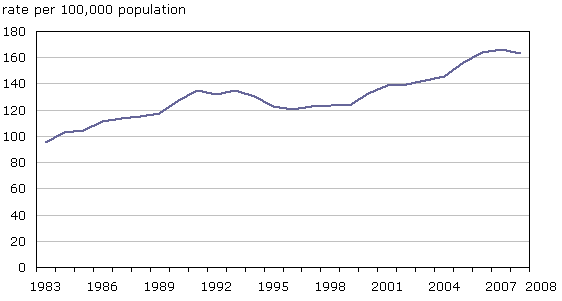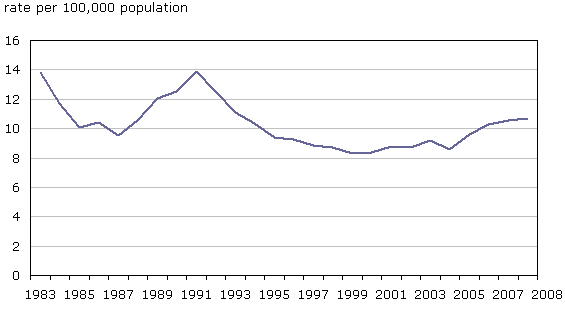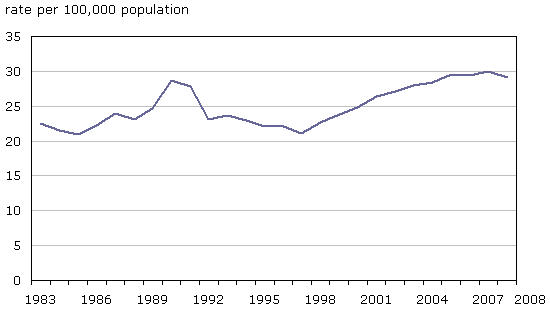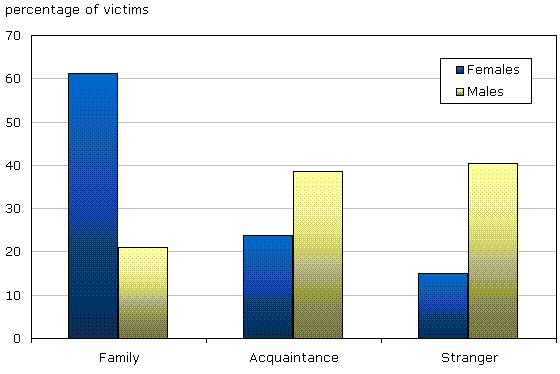Trends in police-reported serious assaults
Archived Content
Information identified as archived is provided for reference, research or recordkeeping purposes. It is not subject to the Government of Canada Web Standards and has not been altered or updated since it was archived. Please "contact us" to request a format other than those available.
By Mia Dauvergne
Serious assaults increase while most other police-reported violent crimes remain stable or decrease
Increases in police-reported serious assault occurred virtually across Canada
Increase in persons accused of serious assault greater among youth than adults
Spouses, acquaintances and strangers account for relatively equal proportions of those accused of level 2 and 3 assaults
Assaults against peace officers normally occur in conjunction with another offence
Assaults against peace officers have higher conviction rates but less severe sentences than level 2 and 3 assaults
Summary
References
Detailed data tables
Notes
This report examines police-reported data on three types of assault: assault with a weapon or causing bodily harm, aggravated assault and assaults against peace officers (including police).1 For the purposes of this report, these three types of assault are referred to as "serious assaults", although the use of this terminology is by no means meant to imply that other forms of assault, such as sexual assault, are not serious.2
In general, incidents of assault are classified by police into one of three categories. Level 1 assaults are the most common and refer to assaults that cause little to no physical harm to victims. Level 2 assaults, or assault with a weapon or causing bodily harm, are those that involve carrying, using or threatening to use a real or imitation weapon. These types of assault also include incidents that involve hurt or injury to a person that interferes with their health or comfort and is more than merely transient or trifling in nature. Level 3 assaults, also referred to as aggravated assaults, constitute those in which a victim is wounded, maimed, disfigured or whose life is endangered.
Assaults against peace officers refer to assaults involving police officers, correctional officers, bailiffs, justices of the peace, municipal by-law officers and others who are employed for the maintenance of public peace. In October 2009, new legislation came into force which creates three levels of assault against a peace officer, similar to the categories for assault in general (LEGISinfo, 2009). The data presented in this report, however, are not impacted by this legislative amendment.
This Juristat article analyzes data on these three types of serious assaults that have been reported to, and substantiated by, Canadian police services between 1983 and 2008. Data are drawn from the Uniform Crime Reporting Survey beginning in 1983 when major changes were made to the Criminal Code definitions of assault that affected the comparability of data prior to this time.3
Data from the Integrated Criminal Court Survey (ICCS) are also used in this article. These data provide information on the decisions and sentencing outcomes for adult and youth court cases involving serious assault in Canada.
Serious assaults increase while most other police-reported violent crimes remain stable or decrease
The trend in the rates of police-reported serious assault over the past 10 years differs from those of most other violent crimes.4 For instance, the rates of homicide, attempted murder, sexual assault, robbery and level 1 assault have generally remained stable or declined. In contrast, the rates of level 2 and 3 assaults, as well as assaults against peace officers, have risen in recent years.
The increases in each type of serious assault began at different times. The rates of level 2 assaults have been generally rising since this information became available in 1983 (Chart 1). Level 3 assaults began rising in more recent years following a period of decline throughout the 1990s (Chart 2), and assaults against peace officers have been rising over the past decade (Chart 3).
Chart 1
Police-reported assaults with a weapon or causing bodily harm (level 2), Canada, 1983 to 2008

Source: Statistics Canada, Canadian Centre for Justice Statistics, Uniform Crime Reporting Survey.
Chart 2
Police-reported aggravated assaults (level 3), Canada, 1983 to 2008

Source: Statistics Canada, Canadian Centre for Justice Statistics, Uniform Crime Reporting Survey.
Chart 3
Police-reported assaults against peace officers, Canada, 1983 to 2008

Source: Statistics Canada, Canadian Centre for Justice Statistics, Uniform Crime Reporting Survey.
In 2008, police reported about 54,000 incidents of assault with a weapon or causing bodily harm, 3,500 aggravated assaults and almost 10,000 assaults against peace officers (Table 1).5 Additionally, about 2,500 assaults against peace officers occurred during the commission of another more serious violent offence. Together, serious assaults accounted for 15% of all violent crimes and about 3% of all crimes reported to police.
Official police-reported statistics likely represent an undercount of the actual number of serious assaults that occur, as not all crimes are known to police. Information from the most recent General Social Survey on Victimization indicates that about half of all victims who had been injured as a result of a physical assault subsequently reported the incident to police. In general, incidents that result in injury to victims are more likely to be reported to police than those that do not (Gannon and Mihorean, 2005).
Increases in police-reported serious assault occurred virtually across Canada
Like the trend in overall violent crime, police-reported rates of serious assault tend to be higher in the territories than in the provinces. In 2008, the rates of all three types of serious assault in Nunavut and the Northwest Territories were close to or more than double those in any of the provinces (Table 2). Provincially, the highest rates were in Saskatchewan with Saskatoon and Regina reporting some of the highest rates among all census metropolitan areas (Table 3). The lowest rates were in Prince Edward Island.
The recent increases in serious assaults have occurred across the country, with only a few exceptions. Some of the largest increases have been in Nova Scotia where the increases in assault level 2 and assault against peace officers were well above those in any other province. In particular, the rate of assaults against peace officers in Halifax was four times higher than 10 years ago.
There are two provinces whose trends in serious assault differ from the norm: Ontario and Quebec. In Ontario, the rates of level 2 and 3 assault have remained relatively stable since the mid-1990s. And, while police-reported assaults against peace officers in Ontario have risen, the increase has been less than the national average.
In Quebec, police have reported gradual declines in the rate of level 3 assault for close to 20 years. Between 1998 and 2008, the rate of this offence dropped in each of Quebec's six census metropolitan areas. This province's increases in assault level 2 and assaults against peace officers, however, were similar to or higher than those reported in other provinces.
Increase in persons accused of serious assault greater among youth than adults
In 2008, approximately 42,000 persons were accused of serious assault in Canada–about 35,000 were accused of level 2 or 3 assault and almost 7,000 were accused of assault against a peace officer. Youth, aged 12 to 17 years, comprised 20% of all accused persons, slightly lower than the proportion of youth accused of violent crime in general.
While the rates of persons accused of serious assault have increased among both adults and youth, the increase has been greater among youth. Between 1998 and 2008, the rate of youth accused of level 2 or 3 assault rose 28% compared to 12% for adults. Youth accused of assault against a peace officer increased by 52%, seven times higher than that for adults (7%).
Spouses, acquaintances and strangers account for relatively equal proportions of those accused of level 2 and 3 assaults
In general, there are three primary situations in which assault with a weapon or causing bodily harm and aggravated assault occur: incidents of family violence6, disputes between acquaintances7 and disputes between strangers. In 2008, each of these situations accounted for about one-third of all level 2 and 3 assaults solved by police (36%, 33% and 31% respectively).8
Differences in the accused-victim relationship become apparent when the sex of the victim is taken into account (Chart 4). In 2008, female victims were more likely than male victims to be assaulted by a family member (61% versus 21%), nearly three-quarters of which were committed by the victim's spouse. Family-related serious assaults against females usually occurred in a private residence (69%) and about 7 in 10 victims suffered some physical injury. Most, however, did not require medical treatment.
Chart 4
Assault with a weapon or causing bodily harm (level 2) and aggravated assault (level 3), by gender of victim and relationship, 2008

Note: Includes incidents in which any violation was classified as an assault with a weapon or causing bodily harm or aggravated assault. The Uniform Crime Reporting Survey captures up to four violations for each incident.
Source: Statistics Canada, Canadian Centre for Justice Statistics, Uniform Crime Reporting Survey.
In contrast to female victims, males were more likely to be seriously assaulted by an acquaintance (38%) or a stranger (40%) in a public or commercial setting, such as the street or parking lot. The level of injury suffered by male victims and the need for medical intervention were similar to that for females.
Assaults against peace officers normally occur in conjunction with another offence
Assaults against peace officers typically involve violations for other offences. In 2008, nearly 7 in 10 of these serious assaults occurred in conjunction with at least one other offence. The most common secondary offences were obstruction of a peace officer (36%), followed by level 1 assault (21%), uttering threats (18%), mischief (14%), failure to comply with a disposition (11%) and breach of probation (9%).9
Relatively few assaults against peace officers in 2008 involved a weapon or resulted in major physical injury. In 2008, police reported that 86% of such assaults were committed without a weapon and less than 1% required the officer to seek professional medical assistance.
Assaults against peace officers have higher conviction rates but less severe sentences than level 2 and 3 assaults
For a variety of reasons, such as insufficient evidence or the use of diversionary measures, many offences do not result in an accused person being processed through the court system. In 2006/2007, there were about 14,000 adult court cases of assault with a weapon or causing bodily harm (level 2), over 1,200 cases of aggravated assault (level 3) and over 3,600 cases of assault against peace officers (Table 4).10,11 In total, these three types of serious assault cases accounted for about 5% of the total adult criminal court caseload.
Conviction rates for cases involving serious assault vary depending on the type of assault. About half of all level 2 and 3 assault cases in 2006/2007 ended in a finding of guilt, similar to the conviction rate for level 1 assault cases as well as violent crime cases in general. The conviction rate for assault against peace officers, however, was among the highest of any violent crime. In 2006/2007, three-quarters of these types of cases ended in a finding of guilt.
Cases involving level 3 assault were more likely to result in a sentence to custody than cases involving other serious assaults. Average sentence lengths for level 3 assaults also tended to be longer, particularly when compared to cases involving assaults against peace officers. Custodial sentences for assaults against peace officers were most similar to those for level 1 assault. These findings are consistent with the maximum custodial penalties associated with assaults: 14 years imprisonment for aggravated assault, 10 years for assault with a weapon or causing bodily harm, and 5 years for assault against a peace officer and for assault level 1.
The findings for youth (12 to 17 years) convicted of serious assault were similar to those for adults (Table 4).12 Youth court cases involving assault against peace officers were more likely to result in conviction than cases involving other forms of serious assault. Custodial sentences were most common and longest for convictions involving level 3 assault. And, while the proportion of cases involving convictions for assault against peace officers was similar to that for level 2 assault, sentence lengths were closer to those for level 1 assault.
Summary
Assault with a weapon or causing bodily harm, aggravated assault and assault against peace officers are among the few police-reported violent crimes to be rising in Canada. Increases over the past 10 years have been reported by police services across the country, with only a few exceptions. The increase in the rate of youth accused over this period was greater than that for adults. Data from adult and youth courts show that cases involving assaults against peace officers are more likely than other types of serious assault to result in conviction. Level 3 assaults, however, are most likely to result in custodial sentences.
References
Brennan, Shannon and Andrea Taylor-Butts. 2008. "Sexual assault in Canada, 2004 and 2007." Canadian Centre for Justice StatisticsProfile Series.No. 19. Statistics Canada Catalogue no. 85F0033M.
/pub/85f0033m/85f0033m2008019-eng.htm (accessed on September 18, 2009).
Gannon, Maire and Karen Mihorean. 2005. "Criminal victimization in Canada, 2004." Juristat.Vol. 25, no. 7. Statistics Canada Catalogue no. 85-002-XIE.
/pub/85-002-x/85-002-x2005007-eng.pdf (accessed on September 18, 2009).
LEGISinfo. 2009. Bill C-14 Home Page. http://www.parl.gc.ca (accessed October 5, 2009).
Detailed data tables
Table 1 Police-reported serious assaults, Canada, 1983 to 2008
Table 2 Police-reported serious assaults, by province and territory, 2008
Table 3 Police-reported serious assaults, by census metropolitan area, 2008
Table 4 Criminal court cases involving serious assaults, adults and youth, 2006/2007
Notes
- For further information on the categories and definitions of serious assault included in this Juristat article, see Criminal Code, R.S.C 1985, c. C-46, s. 267, s. 268, s. 270.
- For more information on sexual assault in Canada, refer to Brennan, Shannon and Andrea Taylor-Butts. 2008. "Sexual assault in Canada, 2004 and 2007". Canadian Centre for Justice StatisticsProfile Series. Statistics Canada, Catalogue no. 85F0033M, No. 19. Ottawa.
- Data from 1983 to 1997 are drawn from the Uniform Crime Reporting (UCR1) Aggregate Survey whereas data from 1998 to 2008 are drawn from the Incident-based Uniform Crime Reporting (UCR2) Aggregate Survey.
- Rates are calculated per 100,000 population.
- Figures are based upon the most serious offence in the incident. One incident may involve multiple violations.
- Includes incidents committed by current and former legal or common-law spouses, boyfriends or girlfriends as well as incidents committed by parents, children, siblings and other extended family members.
- Includes acquaintances, friends, neighbours, business relationships, criminal relationships and authority figures.
- These data are drawn from the UCR2 Incident-based survey and include incidents in which any violation was classified as an assault with a weapon or causing bodily harm or aggravated assault. The UCR Survey captures up to four violations for each incident.
- Categories are not mutually exclusive and will therefore not add up to 100%. These data are drawn from the UCR2 Incident-based survey and include incidents in which any violation was classified as an assault with a weapon or causing bodily harm or aggravated assault. The UCR Survey captures up to four violations for each incident.
- Data are from the Integrated Criminal Court Survey and represent the most recent information available. In 2006/2007, data were received from all provinces and territories representing 95% of the national adult criminal court caseload.
- Figures reflect cases where a serious assault was determined to be the most serious charge in the case. A case is defined as one or more charges against an accused person or corporation, where all of the charges in the case have received a final disposition. It includes all charges against the same person where there are overlapping court dates.
- Data are from the Integrated Criminal Court Survey and represent the most recent information available. In 2006/2007, data were received from all provinces and territories representing 100% of the national youth criminal court caseload.
- Date modified:
